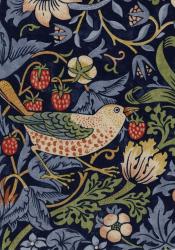William Morris and the Arts & Crafts Movement in the 1880s
William Morris
William Morris was a 19th century socialist, writer, artist, designer and craftsman. Almost 150 years after founding his firm in 1875, Morris & Co., his tapestries, wallpapers, fabrics for furniture and home decor still influence the world of design.
Born in 1834 in Essex, England, into a wealthy family, he was one of nine children who survived to adulthood which is noteworthy for the early 1800s. His childhood is described as idyllic with time spent reading and wandering the surrounding area which was filled with medieval architecture. In his later school years, he trained as an architect after switching from theology studies. The medieval churches left a deep impression on him and his early work included stained glass windows.
Around 1880, the Arts & Craft movement was born as a reaction to what designers believed to be a degradation of fine workmanship in home decoration caused by the mechanization of the industrialized society. More emphasis was now placed on doing a job piecemeal -- in steps by many people --- rather than by one person working as a craftsperson. Morris became the leading figure in this movement.
Before this took place, Morris’s life went through upheaval. He and his family lived at Red House, a red brick manor that architect Philip Webb designed. It was an Arts & Crafts masterpiece with sloping gabled roofs and a cottage garden. To this day, some of the wallpaper that Morris designed is still in the house. The Red House became a country get-away for Morris’s artistic friends. One of Morris’s friends, Dante Rossetti, became entangled in an affair with Morris’s wife, Jane, and the marriage began to disintegrate. The family moved from the Red House to Oxfordshire in 1865 as his personal finances were also sinking. Inexplicably, he invited Rossetti to come live with the family. One cannot imagine how Morris thought this would work in the long run and it didn’t; Rossetti finally left in 1874. Morris found comfort in verse and became one of England’s most famous poets in the 1860s with many of his poems having medieval themes.
By the next year, his own firm was founded. Morris mastered the art of woodblock prints and applied this technique to paper and fabric. His fabric design illustrates his interest in medieval textiles such as the Cluny tapestries. The foliage and birds captured his imagination.
As he mastered the techniques from the past for his dyeing and printing, he also became interested in the preservation of historical buildings, eschewing modern methods. He co-founded The Society for the Protection of Ancient Buildings which is still in existence today. The Society believes in repairing old buildings, not restoring them to modern standards.
William Morris had strong socialist views. He believed that art should be not only enjoyed by all socioeconomic classes of society but available to all people. His legacy was wide ranging and long lasting to this day. The Arts & Crafts movement spread to North America and to France where Art Nouveau began. It was not defined as a particular style but rather beauty and function into the design of whatever was used for the home. William Morris died in 1896 but Morris & Co. continued to trade until 1940. The firm was dissolved in the early months of WWII, no doubt due to the stress of the London Blitz when home decor and furnishings were not at the forefront of the needs of the people However, the licenses for the designs are owned by several companies; the most well known to Americans is Liberty of London who own the license for fabric design.
Toward the end of his life, Morris began a private press in his Kelmscott home, dedicated to Arts & Crafts books. At his death, an ardent admirer and friend, Laurence Hodson, bought the entire collection of Morris’s library and it stayed intact within Hodson’s family for over 100 years. Hodson died in 1933. Recently, the family decided to put the entire collection up for auction. The Bloomsbury Auctions consultant found in a box at the back of the cupboard a draft of an early sonnet by Oscar Wilde and also letters from him offering advice about being a writer. The sonnet was written to Bosie, Lord Alfred Douglas.
Young, Graham. “Wilde Surprises at Heart of a Spellbinding William Morris Treasure Trove.” BusinessLive, 2 April 2013, https://www.business-live.co.uk/retail-consumer/wilde-surprises-heart-sp...

